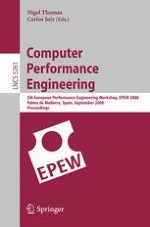2008 | Buch
Computer Performance Engineering
5th European Performance Engineering Workshop, EPEW 2008, Palma de Mallorca, Spain, September 24-25, 2008. Proceedings
herausgegeben von: Nigel Thomas, Carlos Juiz
Verlag: Springer Berlin Heidelberg
Buchreihe : Lecture Notes in Computer Science
